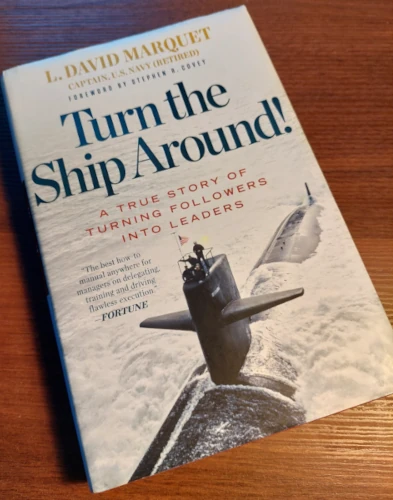Turn the Ship Around!: A True Story of Turning Followers into Leaders - book review
Posted on 22 October 2021 in Books • 4 min read
Whatever sense we have of thinking we know something is a barrier to continued learning.
(David Marquet, "Turn The Ship Around!")

"What does it take to turn a nuclear submarine around?" sprung up in my head, when I saw the cover of the book for the first time. It turns out, the book wasn't literally about turning the ship around. Or rather the definition of a "ship" was not a "nuclear submarine".
What does it take to challenge the decision making and leadership mechanisms in an organization as old and solid as U.S. Navy? Any why should these mechanisms change in the first place?
In December 1998, Captain David Marquet was ordered to take command over the SSN Santa Fe - a nuclear-powered fast attack submarine. She and her crew were to be ready for combat deployment in six months. That was not an ordinary task. Not only Captain Marquet previously spent half a year getting ready to command SSN Olympia - a submarine completely different from technical perspective, he was also assigned to command "The Santa Fe" - the worst-performing submarine in the navy at a time.
However, that rapid change of plan was not coincidental nor random. During his earlier career and training Marquet has experienced and identified the limitations of "One leader commands them all" or broadly "Leader - Follower" approach. The follower learns to rely on the leader to make all decisions rather than to fully engage with the work process to help make the organization run as efficiently as possible. One of the factors that makes this top-down leadership approach appealing is the induced numbness. It absolves subordinates of the hard work of thinking, making decisions, and being responsible and accountable. Santa Fe was a ship where everyone below the captain and the department heads had their brain shut off.
Captain Marquet was committed to "turn Santa Fe around". He describes how he needed to let go of old ideas to make room for new ones. He would make small evolutionary steps to build the bridge from "leader-follower" to the supreme "leader-leader" approach. The core of the leader-leader model is giving employees control over what they work on and how they work. It means letting them make meaningful decisions. The two enabling pillars are competence and clarity.
Marquet discovered that leader-leader structures are significantly more resilient, and they do not rely on the designated leader always being right. Moreover, they spawn additional leaders throughout the organization naturally.
"Turn The Ship Around!" is a story of how a mediocre crew that focused on avoiding mistakes became a crew thriving to achieve excellence. Marquet does a fantastic storytelling, fusing the narrative with practical analysis and guide. Every chapter focuses on a set small set of challenges that the crew and the captain of Santa Fe had to face and the solution they've come up with. All solutions are further described as practical "mechanisms".
Ultimately, this book is a call to action, a manifesto, for all those frustrated workers and bosses for whom the current leadership structure just isn’t working.
(David Marquet, "Turn The Ship Around!")
A crew? - A Tribe!
What I personally find great about Santa Fe's journey is that it resembles a journey through the stages of tribal relationships as described in "Tribal Leadership" [1]. The crew of Santa Fe, was at stage 2: "My life sucks" when Captain Marquet took over. The crew wanted change, even if they didn’t know quite how to do it. And since the leader-follower approach in place, they always had the boss, the ultimate decision maker - merely the captain to blame for every problem.
Captain Marquet was able to to tap into the existing energy of the command, discover the strengths, and remove barriers to further progress. Marquet's determination, commitment and leadership helped the crew to reach the highest tribal stages: Stage 4 "We're great" - and ultimately Stage 5 "Life is Great".
Thoughts
A good leader always remembers what needs to be done, follows up the execution to make sure that it was unimpeachable. A great leader doesn't have to remember everything or follow up every step the team makes. Instead, the leader employs practices which ensure that the team can perform flawlessly without a leader being present. He or she are the part of the team where every member trusts each-other to do their job. That trust comes from the team being competent, being able to make decisions, clearly understanding the goals on all levels - from personal to organizational. That trust means that every single member of the crew is a leader.
What kind of a leader are you? A leader that tells what should be done, controls the execution hides the bigger picture since "it's not their concern"? A leader who wants to be followed? Or a leader who clarifies the bigger picture, helps building competence and lets the team figure out the best way to perform the job? A leader who trusts and is trusted in return? A leader who spawns leaders?
Thanks to David Marquet I made my mind. How about you?
| [1] | Tribal Leadership: Leveraging Natural Groups to Build a Thriving Organization (Dave Logan, John King, Halee Fischer-Wright) |